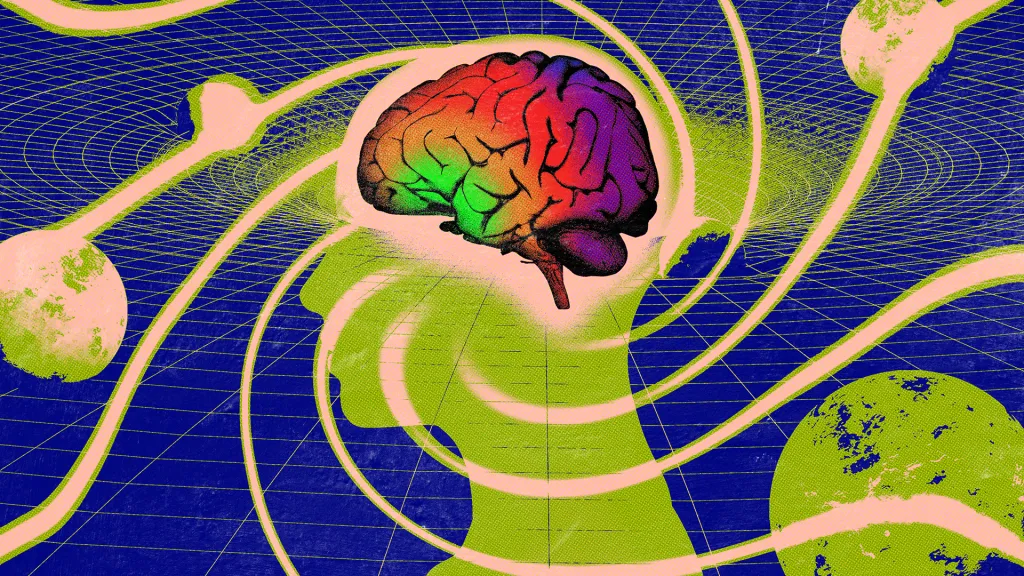The Science Behind DMT: Understanding Its Chemical Structure and Effect
Dimethyltryptamine (DMT) is a powerful psychedelic compound that has fascinated researchers, psychologists, and spiritual seekers for decades. Its effects are profound, often described as producing intense alterations in consciousness, vivid visual and auditory hallucinations, and encounters with seemingly autonomous entities or alternate realities. While DMT’s use as a psychoactive substance dates back centuries in indigenous cultures, modern science has begun to explore its chemical properties and potential therapeutic benefits in more detail. To understand how DMT produces such dramatic effects, we need to delve deeper into its chemical structure, how it interacts with the brain, and why its effects are so unique. THE SCIENCE BEHIND DMT

Chemical Structure of DMT
DMT is a naturally occurring tryptamine, a class of compounds that are derived from the amino acid tryptophan, which is found in various foods and is essential for the production of serotonin. The chemical structure of DMT is similar to other hallucinogens, such as psilocybin (the active compound in magic mushrooms) and LSD, but DMT has its unique characteristics that make it particularly powerful. THE SCIENCE BEHIND DMT
- Chemical Formula: C₁₂H₁₆N₂
- Molecular Structure: DMT consists of an indole ring (a six-membered ring containing nitrogen) attached to an ethylamine group (–CH₂CH₃). This structure is critical in allowing DMT to interact with serotonin receptors in the brain.
The indole ring, which is also present in serotonin and other important neurotransmitters like melatonin, is key to DMT’s psychoactive effects. This molecular similarity explains why DMT is able to mimic serotonin in the brain, interacting with the same receptors to produce its effects. THE SCIENCE BEHIND DMT
DMT and the Brain
Once DMT enters the brain, it exerts its effects by primarily interacting with serotonin receptors, particularly the 5-HT2A receptor, which is heavily involved in regulating mood, perception, and cognition. The serotonin system plays a fundamental role in maintaining balance in various brain functions, including regulating mood, thought processes, and sensory perception. By binding to the 5-HT2A receptor, DMT disrupts normal serotonin signaling, leading to profound alterations in sensory experiences, emotions, and even self-perception. THE SCIENCE BEHIND DMT
The 5-HT2A receptors are concentrated in regions of the brain involved in higher cognitive functions, such as the cortex, and also in the limbic system, which is responsible for regulating emotions and memory. This explains why DMT produces such intense effects on perception, emotions, and cognition. THE SCIENCE BEHIND DMT
In addition to the 5-HT2A receptor, DMT interacts with other serotonin receptors. This may cause vivid hallucinations and intense consciousness changes. The exact mechanisms behind DMT’s effects are still being studied. One theory suggests DMT disrupts the Default Mode Network (DMN). The DMN is active when a person is at rest and thinking self-referentially. THE SCIENCE BEHIND DMT
Endogenous DMT and the Pineal Gland
One of the most intriguing aspects of DMT is that it is not only found in various plants and animals, but it also exists endogenously in the human body. There has been speculation about the role of DMT in the pineal gland, a small, pea-shaped organ located deep in the brain that is often referred to as the “third eye.” The pineal gland is primarily responsible for producing the hormone melatonin, which regulates sleep-wake cycles. THE SCIENCE BEHIND DMT
In the 1990s, the renowned researcher Dr. Rick Strassman hypothesized that the pineal gland might produce DMT during certain altered states of consciousness, such as dreams, near-death experiences, or mystical and spiritual experiences. While this theory has generated a great deal of interest, it remains controversial and has not been definitively proven. Recent research has suggested that although trace amounts of DMT may indeed be produced in the brain, the exact role of endogenous DMT in human consciousness remains uncertain. THE SCIENCE BEHIND DMT
Some researchers also point to the fact that DMT is found in a wide range of plants and animals, many of which have evolved in different ecological niches, suggesting that DMT might serve biological functions beyond just psychoactive effects. However, more research is needed to fully understand the role of endogenous DMT in the human brain. THE SCIENCE BEHIND DMT
The Effects of DMT
When consumed, DMT produces intense and often profound effects that are different from other psychedelics due to the speed and intensity with which they occur. The effects of DMT can vary based on the method of administration, the individual’s mindset, and the environment, but they generally share some common themes. THE SCIENCE BEHIND DMT
1. Visual and Auditory Hallucinations
The most striking effect of DMT is the vivid, often overwhelming visual and auditory hallucinations that users experience. These can include geometric patterns, intricate kaleidoscopic visuals, and intense color shifts. Many users report seeing “entities” or “beings” that seem to exist in a separate reality. These encounters are often described as autonomous, intelligent, and capable of communication. The visuals and auditory experiences can be so vivid that users often have difficulty distinguishing them from objective reality. THE SCIENCE BEHIND DMT
2. Altered Sense of Time and Space
DMT distorts time and space, making users feel as if they’ve traveled to other dimensions. Time may feel altered, either slowed or sped up. Users report that a 20-minute trip feels like hours. This alteration of time perception is one of the defining features of the DMT experience. THE SCIENCE BEHIND DMT
3. Ego Dissolution and Loss of Self
One of the most profound effects of DMT is ego dissolution—a loss of the sense of self, or “I”. The boundaries between the user and the external world seem to dissolve, and the individual may feel as though they are part of everything, or that they have merged with a larger universal consciousness. This experience is often described as one of the most transformative aspects of DMT and is central to the “spiritual” or “mystical” experiences that many users report. THE SCIENCE BEHIND DMT
4. Emotional Shifts
While many people report profound euphoria and feelings of bliss during a DMT experience, others may experience fear, anxiety, or confusion. These emotional shifts can be intense, and some users may feel overwhelmed by the power of the experience. The setting and the user’s mental state play a significant role in determining whether the experience is positive or challenging. THE SCIENCE BEHIND DMT
5. Entity Encounters
A truly unique feature of DMT, which sets it apart from other psychedelics, is the phenomenon of entity encounters. Many users report meeting non-human entities, often described as intelligent, autonomous beings that communicate with the user in various ways. Some describe these entities as alien-like, while others perceive them as benevolent, wise, or even divine. These encounters can be a defining element of the DMT experience. Leading some to believe that DMT might provide a window into alternate dimensions or spiritual realms. THE SCIENCE BEHIND DMT
How DMT is Consumed
DMT can be consumed in a variety of ways, and the method of ingestion influences both the intensity and duration of the experience. THE SCIENCE BEHIND DMT
1. Smoking or Vaporizing
Firstly, the most common method of using DMT is by smoking or vaporizing the crystalline form of the compound. This produces an immediate onset of effects, with users experiencing intense visuals and alterations in consciousness within seconds. The peak of the experience is typically reached within a few minutes, and the entire experience may last between 15 and 45 minutes, depending on the dose. THE SCIENCE BEHIND DMT
2. Oral Consumption (Ayahuasca)
When people consume DMT orally, they typically take it in the form of ayahuasca, a traditional South American brew. The brew combines DMT-containing plants with an MAOI (monoamine oxidase inhibitor). The MAOI prevents DMT from breaking down in the digestive system, allowing absorption and prolonging activity for 4 to 6 hours. The experience starts more gradually compared to smoking DMT and has a more contemplative, introspective quality. THE SCIENCE BEHIND DMT
Why DMT Produces Such Powerful Effects
The exact mechanisms behind DMT’s profound effects remain a subject of ongoing research. However, the compound’s ability to interact with serotonin receptors, especially the 5-HT2A receptor, plays a crucial role in altering brain function and perception. Additionally, DMT’s rapid onset and short duration make it an especially intense psychedelic, giving users a powerful, fleeting glimpse into alternate realities and altered states of consciousness. THE SCIENCE BEHIND DMT
One leading hypothesis is that DMT disrupts the Default Mode Network (DMN). A collection of brain regions associated with self-reflection, ego, and the maintenance of normal waking consciousness. By disrupting this network, DMT appears to enable users to experience a state where their sense of self is suspended, which could explain the intense feelings of ego dissolution and the vivid hallucinations that characterize the experience. THE SCIENCE BEHIND DMT
Conclusion
Dimethyltryptamine (DMT) is one of the most potent and fascinating psychoactive substances known. Its chemical structure allows it to interact with serotonin receptors in a way that leads to profound changes in perception, emotion, and consciousness. DMT’s effects—ranging from visual and auditory hallucinations to profound spiritual experiences—are often described as transformative and life-changing. Despite its widespread use in spiritual and shamanic contexts, much about DMT remains mysterious. However, modern neuroscience is beginning to uncover more about its role in the brain and its potential applications for understanding the nature of consciousness, the mind, and. THE SCIENCE BEHIND DMT
